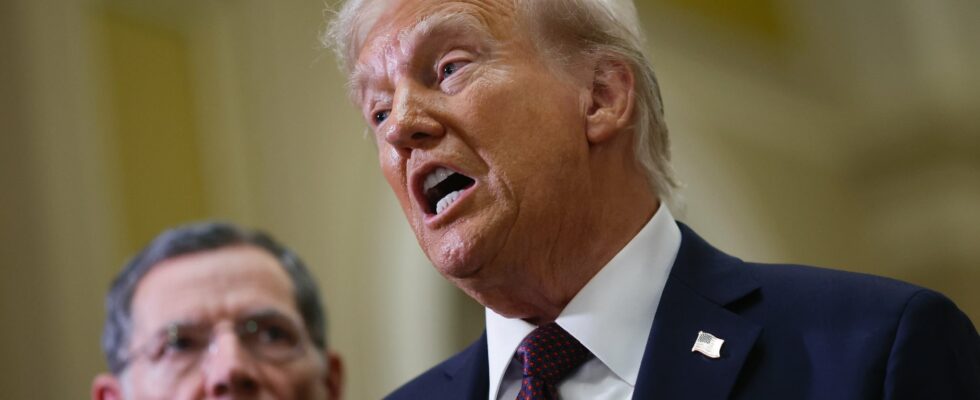With a tanned complexion, furrowed eyebrows, his gaze fixed on the camera, the Republican candidate drums on a pastel blue background: “The Panama Canal is a sovereign territory of the United States […] we bought it, we paid for it, and we intend to keep it.” Make no mistake, the verb is not that of the president-elect who is preparing to regain control of the White House, Donald Trump We are in the mid-70s, in the middle of the presidential campaign, Ronald Reagan is in difficulty facing the current president Gerald Ford. How to rally the conservative electorate to his cause? canal including the retrocession to Panama is about to be ratified.
The issue is grafted onto the context. War in Vietnam, oil crisis, stagflation, Watergate scandal which led to the resignation of Richard Nixon… On the eve of the 1976 presidential election, the United States found itself weakened by a first half of the decade punctuated by unprecedented shocks. And if the majority of elected officials and the American population are indifferent to the case of the Panama Canal, some see in this renunciation “the last nail in the coffin of American greatness”, explains Françoise Coste, historian specializing in the Republican Party and author of Reagan (Perrin), a biography dedicated to the former tenant of the White House (1981-1988).
Also, Ronald Reagan saw the benefit of standing up as a defender of keeping the Panama Canal under the American flag. The question then becomes a symbol of patriotism, the compass of “Make America Great Again”. The former actor turned politician will bring it back four years later, after having failed against Jimmy Carter. Between the two presidential campaigns, treaties providing for the handover of the canal were signed between the Democratic president and the supreme leader of the Panamanian revolution, Omar Torrijos. Fuel for the Republican, who sees his image as “savior” of the United States reinforced.
Electoral argument for Ronald Reagan, means of pressure for Donald Trump
Four decades later, Donald Trump is trying to wear the same finery. At Christmas turkey time, the president-elect is bringing up to date his predecessor’s campaign promise: to keep – or rather recover – the Panama Canal. And although it came under Panamanian sovereignty in 1999, the arguments brandished are almost identical: restore the greatness of the United States and protect the country’s interests threatened by geopolitical rivals – the USSR under Ronald Reagan, China under Donald Trump. If he has caused liters of anchor to sink in the press across the Atlantic, the parallel stops there.
Firstly, because “the canal had not yet been returned to Panama and still belonged to the United States when Reagan campaigned on it,” points out historian Françoise Coste. It was therefore neither a question of takeover nor “annexation by force”, but simply of maintaining the status quo of the Panama Canal. “Unlike Trump, Reagan had a deep respect for institutions and international law, such that he would never have adhered to Trump’s expansionist discourse targeting the Panama Canal and other sovereign territories,” says assert the specialist of the presidency of the Teflon chairman.
Two, because the goals of Ronald Reagan of the 80s diverge from those of Donald Trump today. Unlike his predecessor who had made it a campaign argument, the blonde-haired Republican only brought up the subject of the canal once elected. “His idea is not so much to unite the most conservative electorate around the issue as Reagan sought to do, but rather to use pressure tactics where the interests of the United States lie,” deciphers Lauric Henneton, lecturer at the University of Versailles Saint-Quentin and author of the work The American dream put to the test by Donald Trump (ed. Vendémiaire, 2020).
Donald Trump and the method of “bully“
Internally, the interest is not neutral: “Threatening to annex the canal could, for example, be a way of obtaining a reduction in rights of passage,” notes Lauric Henneton. On the international scene, it is a way for Donald Trump to react in accordance with his reading grid. The former real estate mogul would have retained a Cold War logic that prevailed in the 1980s. “In Trump’s eyes, Putin’s Russia and Xi Jinping’s China have taken the place of the USSR of the time Reagan”, confirms historian Françoise Coste. Thus, faced with the expansionist desires of major geopolitical rivals, the next occupant of the Oval Office seeks to establish the predominance of the United States.
Do not give the Middle Kingdom the freedom to establish ports on the shores of the Panama Canal. Ensure that Moscow and Beijing do not monopolize the natural resources present in Greenland – which it has also threatened to annex like Canada – not to mention the crucial issue of the maritime routes which will open with the melting of ice caps. To do this, the person who is about to take the oath plays on a triptych of ‘constraint, persuasion and dissuasion’. “He uses his alpha male side as a geopolitical instrument,” explains Lauric Henneton. And smile: “Donald Trump is a kind of bully like those in playgrounds. However, when a bully asks for our snack, we give it to him to avoid having his teeth broken, right?”
.
